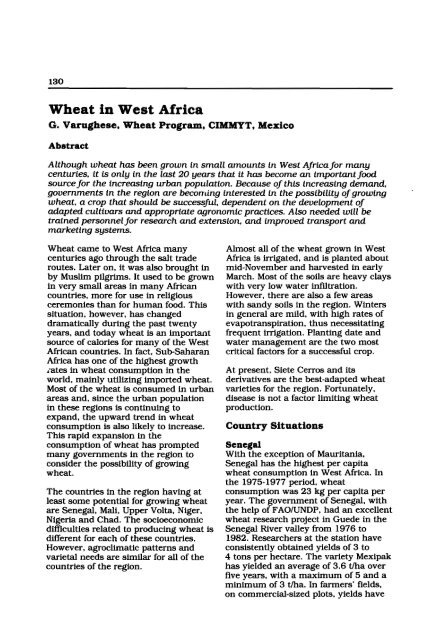the Symposium on Wheats for More Tropical Environments - cimmyt
the Symposium on Wheats for More Tropical Environments - cimmyt
the Symposium on Wheats for More Tropical Environments - cimmyt
- No tags were found...
You also want an ePaper? Increase the reach of your titles
YUMPU automatically turns print PDFs into web optimized ePapers that Google loves.
130Wheat in West AfricaG. Varughese, Wheat Program, CIMMYT, MexicoAbstractAlthough wheat has been grown in small amounts in West Africa<strong>for</strong> manycenturies, it is <strong>on</strong>ly in <str<strong>on</strong>g>the</str<strong>on</strong>g> last 20 years that it has become an importantfoodsource<strong>for</strong> <str<strong>on</strong>g>the</str<strong>on</strong>g> increasing urban populati<strong>on</strong>. Because of this increasing demand.governments in <str<strong>on</strong>g>the</str<strong>on</strong>g> regi<strong>on</strong> are becoming interested in <str<strong>on</strong>g>the</str<strong>on</strong>g> possibility ofgrowingwheat, a crop that should be successful, dependent <strong>on</strong> <str<strong>on</strong>g>the</str<strong>on</strong>g> development ofadapted cultivars and appropriate agr<strong>on</strong>omic practices. Also needed will betrained pers<strong>on</strong>nel<strong>for</strong> research and extensi<strong>on</strong>, and improved transport andmarketing systems.Wheat came to West Mrica manycenturies ago through <str<strong>on</strong>g>the</str<strong>on</strong>g> salt traderoutes. Later <strong>on</strong>, it was also brought inby Muslim pilgrims. It used to be grownin very small areas in many Mricancountries, more <strong>for</strong> use in religiouscerem<strong>on</strong>ies than <strong>for</strong> human food. Thissituati<strong>on</strong>, however, has changeddramatically dUring <str<strong>on</strong>g>the</str<strong>on</strong>g> past twentyyears, and today wheat is an importantsource of calories <strong>for</strong> many of <str<strong>on</strong>g>the</str<strong>on</strong>g> WestAfrican countries. In fact, Sub-SaharanMrica has <strong>on</strong>e of <str<strong>on</strong>g>the</str<strong>on</strong>g> highest growth...ates in wheat c<strong>on</strong>sumpti<strong>on</strong> in <str<strong>on</strong>g>the</str<strong>on</strong>g>world, mainly utiliZing imported wheat.Most of <str<strong>on</strong>g>the</str<strong>on</strong>g> wheat is c<strong>on</strong>sumed in urbanareas and, since <str<strong>on</strong>g>the</str<strong>on</strong>g> urban populati<strong>on</strong>in <str<strong>on</strong>g>the</str<strong>on</strong>g>se regi<strong>on</strong>s is c<strong>on</strong>tinuing toexpand, <str<strong>on</strong>g>the</str<strong>on</strong>g> upward trend in wheatc<strong>on</strong>sumpti<strong>on</strong> is also likely to increase.This rapid expansi<strong>on</strong> in <str<strong>on</strong>g>the</str<strong>on</strong>g>c<strong>on</strong>sumpti<strong>on</strong> of wheat has promptedmany governments in <str<strong>on</strong>g>the</str<strong>on</strong>g> regi<strong>on</strong> toc<strong>on</strong>sider <str<strong>on</strong>g>the</str<strong>on</strong>g> possibility of grOWingwheat.The countries In <str<strong>on</strong>g>the</str<strong>on</strong>g> regi<strong>on</strong> haVing atleast some potential <strong>for</strong> growing wheatare Senegal, Mali, Upper Volta, Niger,Nigeria and Chad. The socioec<strong>on</strong>omicdifficulties related to producing wheat isdifferent <strong>for</strong> each of <str<strong>on</strong>g>the</str<strong>on</strong>g>se countries.However, agroclimatic patterns andvarietal needs are similar <strong>for</strong> all of <str<strong>on</strong>g>the</str<strong>on</strong>g>countries of <str<strong>on</strong>g>the</str<strong>on</strong>g> regi<strong>on</strong>.Almost all of <str<strong>on</strong>g>the</str<strong>on</strong>g> wheat grown in WestAfrica is irrigated, and is planted aboutmid-November and harvested in earlyMarch. Most of <str<strong>on</strong>g>the</str<strong>on</strong>g> soils are heavy clayswith very low water infiltrati<strong>on</strong>.However. <str<strong>on</strong>g>the</str<strong>on</strong>g>re are also a few areaswith sandy soils in <str<strong>on</strong>g>the</str<strong>on</strong>g> regi<strong>on</strong>. Wintersin general are mild, with high rates ofevapotranspirati<strong>on</strong>. thus necessitatingfrequent irrigati<strong>on</strong>. Planting date andwater management are <str<strong>on</strong>g>the</str<strong>on</strong>g> two mostcritical factors <strong>for</strong> a successful crop.At present, Siete Cerros and itsderivatives are <str<strong>on</strong>g>the</str<strong>on</strong>g> best-adapted wheatvarieties <strong>for</strong> <str<strong>on</strong>g>the</str<strong>on</strong>g> regi<strong>on</strong>. Fortunately,disease is not a factor limiting wheatproducti<strong>on</strong>.Country Situati<strong>on</strong>sSenegalWith <str<strong>on</strong>g>the</str<strong>on</strong>g> excepti<strong>on</strong> of Mauritania.Senegal has <str<strong>on</strong>g>the</str<strong>on</strong>g> highest per capitawheat c<strong>on</strong>sumpti<strong>on</strong> in West Africa. In<str<strong>on</strong>g>the</str<strong>on</strong>g> 1975-1977 period, wheatc<strong>on</strong>sumpti<strong>on</strong> was 23 kg per capita peryear. The government of Senegal, with<str<strong>on</strong>g>the</str<strong>on</strong>g> help of FAO/UNDP, had an excellentwheat research project in Guede in <str<strong>on</strong>g>the</str<strong>on</strong>g>Senegal River valley from 1976 to1982. Researchers at <str<strong>on</strong>g>the</str<strong>on</strong>g> stati<strong>on</strong> havec<strong>on</strong>sistently obtained yields of 3 to4 t<strong>on</strong>s per hectare. The variety Mexipakhas yielded an average of 3.6 t/ha overfive years, with a maximum of 5 and aminimum of 3 t/ha. In farmers' fields.<strong>on</strong> commercial-sized plots. yields have

















